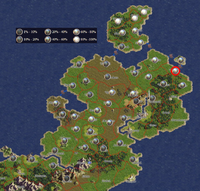The Church of Sartan
| The Church of Sartan | |||||
|---|---|---|---|---|---|
 The Flame of Sartan (the Symbol of the Faithful) | |||||
| Information | |||||
| Continent / Island | Far East | ||||
| Main Temple | Ossaet | ||||
| The Elders | Martin Octavius Azgath Cyrith Jatha Cyrith Martin Octavius Aeneas Quintus Ennius | ||||
| Temples and Shrines | |||||
| Region | Temple (size) | ||||
| Ossaet | Cathedral (4) | ||||
| Ozrat | Cathedral (4) | ||||
| Semon | Large Church (3) | ||||
| Tuhpos | Large Church (3) | ||||
| Akanos | Large Church(3) | ||||
| Arempos | Church (2) | ||||
| Hosiel | Church (2) | ||||
| Unotosa | Church (2) | ||||
| Abilotiel | Church (2) | ||||
| Ansopen | Chapel (1) | ||||
| Hupar | Chapel (1) | ||||
| Upasael | Chapel (1) | ||||
| Anaos | Chapel (1) | ||||
| Enlod | Chapel (1) | ||||
| Itomazh | Chapel (1) | ||||
| Believers | |||||
| Nobles | 31 | ||||
| Commoners | ~106,000 | ||||
 Spread of the Church of Sartan | |||||
(ooc: The Church requires a symbol, a symbol of Sartan. Join the design competition and help improve the Church.)
Introduction
The Church of Sartan finds its origins on the East Continent in Ibladesh and is a variant of the Church of Ibladesh. They follow the four Gods Ramsus, Overlord and Supreme Leader, Sartan, God of War, Tersea, God of Trade and Economics and Kokini, God of Stealth and Mischief. While the Church of Sartan acknowledges the existence of all fours Gods we only follow Sartan, God of War. Very little is known or written about Sartan in the holy texts and scriptures, but from the little we have discovered we know that Sartan was once a mortal warrior. He followed a rigorous moral code of battle and honour. That earned him a lot of respect and eventually a place among the Gods. Its believed that Sartan arose from the ashes in the battle of Nem-e-kabu, where he was slain. His rising changed the tide of war and since then warriors have followed His moral code. A lot of research is still done and still sometimes certain Artifacts giving more information about Sartan fall in the hands of Followers. Sartan (and the other Gods) is known to work in mysterious ways. Most of the times he guides people to do the right thing and he reveals only that which the people need to know at the moment they need to know it. There are tales known of Followers describing this guidance.
An Age of Darkness
Why exactly the Overlord came isn't known, they say that Sartan was forbidden to interfere with mortals beyond the East Continent. Other claim that Ramsus never proclaimed the Church of Sartan as a sect of the Church of Ibladesh and sought to end the self invited ramification of His religion, mostly because He wasn't in control of it. But most clergymen of the Church of Sartan believe that Ramsus feared Sartan's growing strength. As not only the followers of the Church of Ibladesh hailed His name, but also those of the Church of Sartan. The writings say that those who believe channel energy to their God on mystical ways, whether it be through anxiety or love. Being hailed by the creation makes a God even far more powerful. The clergymen believed that Ramsus came to the Far East to put a stop to it. And Sartan as the youngest among the four Gods needed to learn His place. To secure his position as Overlord, Ramsus presented himself as the evil God, Adghar. The followers of Adgar were easily convinced and worshiped Ramsus under another name. With His renewed strength Ramsus engaged Sartan into an eternal struggle. For years they fought each other, an everlasting battle between these deities. But even though He could not defeat Sartan, He did distracted Him from aiding His followers in battle. Sartania and Arcachon waged their religious war against each other, but without the aid of Sartan, it came with a high price. Sartania lost many regions, either to Arcaea or Arcachon. And believers of the Church sought their support elsewhere. Through the exhaustion of war, Sartan lost many followers, and so strength to hold off Ramsus. Eventually Ramsus won the battle and exiled Sartan to the 'underworld'. Probable to serve as punishment, to watch how Ramsus would finish off every single follower of the Church of Sartan, or just to prevent any intervention with the mortal world. But up till now, the truth behind these events hasn't seen the daylight yet. And after the fall of Sartania, the Sartanian nobility remained together and traveled south far from the influence of Ramsus. If Ramsus remained to meet the speculations of the mortal beings or just left isn't known. And it was the young deceased hero, sir Wixalot Danlawer who ascended High Priest Roberd Ghia's soul to confront him with the current situation and so the importance of his mission. And if he sought to contact Sartan back in the mortal world, he required to look into the fire and allow his heart to speak through his soul, and Sartan would listen to his words. According to sir Wixalot, Sartan has learned to control some of the Darker powers which hold their presence in the undead world. And it's since that day that the followers of Sartan attend to fire, as a symbol of warmth and light, a symbol of Sartan.
Sartan's Code of Conduct
The Moral Code of Conduct, once formed by Sartan himself. All Followers of Sartan strictly follow this.
The moral code of conduct was formed by Sartan in his formative years - when he was still naive and easily impressionable. The code of conduct was considered rigorous and challenging to the mind, soul and body. While the moral code just applied to Sartan, priests and priestesses that followed extended the code to adapt each class of people. While most of the code is common to all - some has been adapted to suit the hierarchy of people. These extensions were found in runic texts found in the Ibladesh library and copies sent over to Sartania by family members. Read about Sartan's Morale Code of Conduct and be inspired by His wisdom and prosperity.
Book of Prayers
The Book of Prayers used by the Followers of the Church of Sartan. Within it resides a mixture of texts, proverbs, prayers, wise sayings about Sartan and the Church. Many nobles and also commoners do their best to live by these prayers; they are the teachings of Sartan as He wrote the texts down with His own divine hands.
"No one makes a greater mistake than he who does nothing because he can only do a little." [Book Of Prayers 3]
Tales and Visions
Various Tales and Visions of noble followers describing the guidance and blessings they have received from Sartan. Sartan has guided His followers for generations, and many tales about his guidance have appeared and written down, and stored within the temples of Sartan.
Sermons
Sermons of priests of Sartan, in honour of His name, spoken to convert the minds of our fellow nobles. The sermons are an inspiration to those who wish to take up the cloth, but they also contain Sartan's wisdom, and understanding about the path we're walking.
Temples
Throughout the years, new Temples are built to honour Sartan. Information on the Temples and Shrines that have emerged in honour of Sartan are registered here, together with a description about these Temples from the Lords who constructed them, or maintain them at the moment.
|
|
Ranks and Members
Information on the Ranks in the Church of Sartan. Explaining the prestige and responsibilities that comes with each position within the Church. As the Prophet isn't among us any more, the High Priests lead the Church of Sartan into the direction Sartan desires. Also the current noble followers are registered together with their current rank.
Views
Information on the Views of the Church of Sartan on other Religions on the Far East and beyond. The Church of Sartan finds it's origin on the East Continent in the Church of Ibladesh, so there are many other faiths who think to compete with the might of Sartan. They see Him as a lesser God, a demon, or just one of them, while we only worship His greatness: Sartan, the God of War.
| The Church of Sartan | |||||
| Writings | Sartan's Morale Code of Conduct • Book of Prayers | Image: Symbol of the Church | |||
| Descriptions | Hierarchy • Temples • Views • Organisation | ||||
| Noble Narrations | Tales and Visions • Sermons | ||||
| Believers | Nobles • Religious Spread | ||||